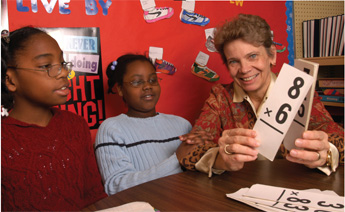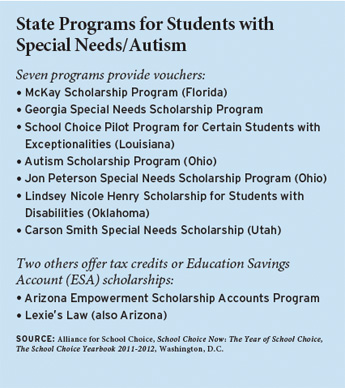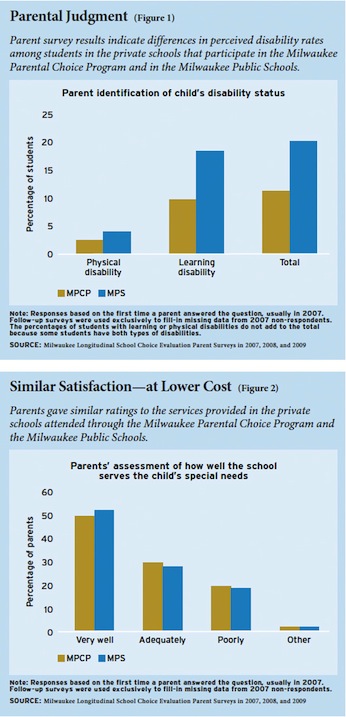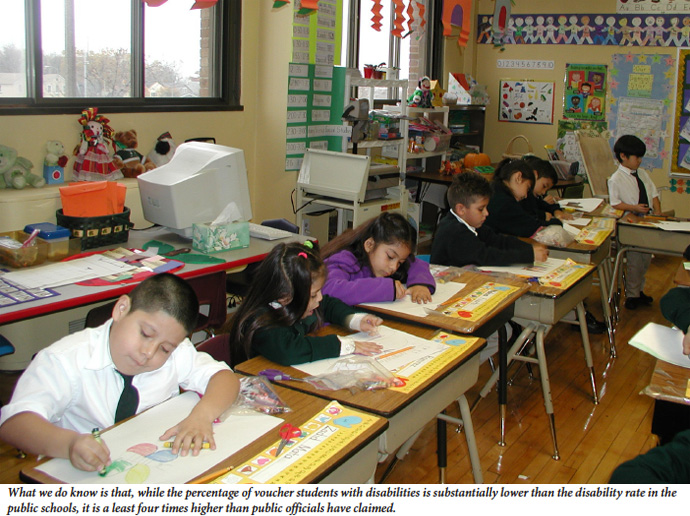
Nine school voucher programs in seven states specifically provide choice for families with disabled children (see sidebar). In Florida, for example, more than 22,000 students with disabilities receive McKay Scholarships to attend private schools at a per-student cost to the government that averaged $7,220 in 2010–11. But what about the private schools that participate in voucher programs open to all low-income families, such as those in Milwaukee, Cleveland, New Orleans, and Washington, D.C.? Do these schools exclude most students who in a public school setting would be identified as in need of special education?
Critics of voucher programs often argue that private schools do exclude most disabled students, and the matter occasionally has been the subject of litigation. Yet accurate information on students with disabilities served by private schools is notable for its absence.
The main reason for the lack of accurate information is that private schools do not operate under the provisions of the federal law that furnishes aid to the states for students identified as needing special education. Public schools expend considerable resources identifying children eligible for special services, both because they are under an obligation to provide those services and because they receive additional funds from federal and state governments if a child is identified as having a disability that affects their learning. Those obligations, rights, and funding support do not apply if parents choose to place their children in private schools with the help of a voucher. By and large, private schools have not developed the capacity to identify children with disabilities, and many of them are reluctant to do so, as they believe it leads to stigmatization of the children.
In other words, a child who may be classified as in need of special education in a public school may not be classified as such if his or her family chooses a private school, using a voucher to defray the cost. As a result, any official statistics on the prevalence of students with disabilities in public and private schools can be highly misleading.
We have not been able to surmount all of the obstacles to identifying the percentage of students in private schools who would have been identified as in need of special education in public schools, but we believe we have fairly accurate information on this question for the country’s largest and longest-running school-voucher program. The Milwaukee Parental Choice Program (MPCP), first established in 1990 and steadily expanded to include more private schools and more students in subsequent years, now serves more than 23,000 students who attend 107 different private schools. The annual voucher a school receives for each MPCP student is approximately $6,000. MPCP thus provides an excellent context for detecting the admission policies of private schools when a modest-value voucher program for low-income students is operating at scale.
In 2006, the State of Wisconsin authorized our research team to conduct a five-year evaluation of MPCP. Through the course of that study, we collected a wealth of data about the students in the voucher program and in the Milwaukee Public Schools (MPS) that permit us to estimate what proportion of the voucher student population would qualify for special education if the students were enrolled in public schools instead.
Drawing on different sources of data and various analytic methods, we estimate that anywhere between 7.5 and 14.6 percent of voucher students have disabilities that would land reported by the Wisconsin State Department of Public Instruction (DPI), a figure that gave rise to a lawsuit alleging discrimination by the MPCP program.
Following is a discussion of the procedures we followed to obtain our estimates and an explanation for the disparity between our estimates and the ones DPI has provided.
 Structure of Special Education
Structure of Special Education
As mentioned previously, receiving a special education designation brings with it certain legal rights for services or accommodations in the public educational sphere, as provided by the federal law known as the Individuals with Disabilities Education Act (IDEA). Once so designated, public school students are entitled to receive a free and appropriate public education (FAPE), to include special education services in the least restrictive environment possible and according to an individualized education program (IEP). A student’s IEP is drawn up by a committee that includes the student’s parents or guardians, local public-school officials, and relevant medical or psychological diagnosticians and care providers. The resulting special services and accommodations are funded through a combination of federal, state, and local monies based on formulas established in law. In Wisconsin, the federal government pays about 11 percent of the extra cost of educating each special-education student, with the state paying 26 percent and the local public-school district covering the remaining 63 percent.
The legal and funding structure surrounding students with disabilities in the private sector differs greatly from the situation in the public sector. Unless a public school district itself places a special education student in a private school, the IEP and additional funding associated with a student with a disability in the public sector does not transfer with the student if the child enrolls in a private school. The point is made in an August 2011 DPI memo on the subject:
Students with disabilities attending voucher schools as part of the MPCP are considered parentally placed private school students and as such, DPI treats them in the same fashion as students attending private non-voucher schools. Under [state law] parentally placed private school students are…not entitled to a Free and Appropriate Public Education.
If a parent enrolls a student with special needs in a private school, that student must surrender her legal rights to special educational services. Private schools are not required by federal law to enroll students with special needs, and they are not entitled to any additional resources from the state if they do so. Private schools can either accommodate the student themselves, using whatever resources they have, or negotiate with public school officials regarding the provision of special services to the student by the public school system with additional public funds (a process called “equitable services”).
Maintaining a count of those thought to be in need of special services also varies by sector. In the public sector, careful record keeping is stressed because disability status has major implications for the kinds of instructional and other services students will receive. In the private sector, special education tends to be handled much less formally, inasmuch as schools are ordinarily not required to follow formal procedures in diagnosing or serving students with special educational needs.
Given the contrasts between how special education is governed and managed in the public and private education sectors, we hypothesize the following:
1. The same student will have a higher likelihood of being identified as in need of special education if in a public school than if in a private school.
2. Given the funding available for extra services for disabled children attending public schools, a higher proportion of students with disabilities than those without disabilities will choose to remain in the public sector rather than use a voucher.
3. Any data that rely on official reports of disability will under-count the percentage of students in private schools who would have been identified as in need of special education had they attended public schools.
To test these hypotheses, we used two alternative methods to estimate the actual percentage of students in private schools who would have been identified as in need of special education in public school had they selected that sector.
Method I: Same Student, Different Sector
The better of our two methods relies on information from those students who attended schools in both the public and the private sectors during the course of our study. During the five years of our evaluation, 20.1 percent or 1,475 of the 7,338 students in our MPCP and MPS study panels switched from one school sector to the other, in some cases multiple times.
We received enrollment files from MPS each year that included information on the special education status of each MPS student. We also collected enrollment lists from every private school in MPCP and asked school officials to indicate if students had disabilities that qualified them for special education. For students who switched school sectors during the study period, we can determine whether those who were identified as needing special education in the public sector were similarly identified when they attended private schools, and vice versa. In other words, we can use each student in our study as his or her own control group to learn whether disability designations vary by sector.
Our analysis indicates that Milwaukee students who switched between the public and private school sectors were much more likely to be identified as in need of special education when they were in the public sector. On average, controlling for factors such as year and student grade, those who attended schools in both sectors were classified as in need of special education at the rate of 9.1 percent when attending private schools but at a rate of 14.6 percent when attending Milwaukee’s public schools. If we assume that a student’s need for special education did not change at the time the student switched sectors, this suggests that 5.5 percent of students attending private schools were not identified as in need of special education but would have been had they been attending public school. In other words, the identification rate in the public schools appears to be 60 percent higher (the 5.5 percent increment divided by 9.1 percent) than in the private schools. The identification rate was higher when students were in MPS both because many students who switched from MPCP to MPS received special education designations in MPS and because many students with special education designations in MPS shed them when they enrolled in MPCP schools.
The 14.6 percent MPCP disability rate is based only on students who switched sectors (35 percent of MPCP students). Those students appear to have higher rates of disability than those who did not switch. Based on principal surveys, for the 65 percent of MPCP students who did not switch, the disability rate was 3.75 percent. To get an overall rate for MPCP students, we compute a weighted average for the two groups of 7.5 percent. We suspect that this rate is conservative, since several voucher school principals told us they resist labeling students in such a way. Combining this conservative estimate with the estimate from our analysis of only students who switched sectors yields a range of 7.5 to 14.6 percent, which we think captures the likely student disability rate in MPCP.

Method II: Parental Estimates of Disability Rates
Our second estimate of the student disability rate in MPCP comes from interviews with parents. In 2007 we interviewed a random sample of parents of MPCP students in grades 3–8, all the parents of MPCP 9th graders, and a sample of parents of MPS students who were matched to the sample of MPCP students based on their grade in school, neighborhood of residence, ethnicity, test-score performance, and other characteristics. We expanded this sample with additional parents of 3rd-grade students similarly chosen in 2007 and 2008. Altogether, we interviewed a majority of the parents of 3,669 students in MPCP and 3,669 students in MPS.
The survey included the following questions:
• Does [child’s name] have any physical disabilities?
• Does [child’s name] have any learning disabilities?
If a parent answered yes to the learning disabilities question, we further asked,
• How well do the facilities at [child’s name] school attend to his/her particular needs?
According to parental responses to the first two of these questions, 2.5 percent of students in MPCP have a physical disability and 9.8 percent have a learning disability (see Figure 1). The corresponding rates reported by parents of MPS students were 4.1 percent and 18.5 percent for physical and learning disabilities, respectively. Combining the categories and eliminating overlapping cases, it is estimated that the disability rate in the MPCP sector is 11.4 percent, as compared to 20.4 percent for the MPS sector.
There is every reason to believe that these parental responses are consistent and fairly accurate indicators of what the parents are told by school officials and what they themselves know about their children. The official MPS rate for this time period is between 18 and 19 percent, just slightly less than the 20.4 percent reported by our MPS parents. The 11.4 percent disability rate for MPCP students based on our survey is midway between the 7.5 percent rate for all students in MPCP based on school staff designations and the 14.6 percent rate based on observing some of the students in both school sectors.
It is interesting that within a scaled-up, long-standing voucher program, parental satisfaction with services for students with disabilities achieves a balance across sectors. Similar levels of satisfaction with special education services are reported, regardless of whether the student was in MPCP or MPS (see Figure 2). Presumably, the choice of sectors and schools allowed parents to obtain an educational setting they view as appropriate for their child.

Discussion
Our estimates of the prevalence of MPCP students who have a disability range from 7.5 to 14.6 percent. The 14.6 percent estimate is based on the identification by public schools of the need for special services for those students who attended school in both sectors, while parental reports peg the rate at 11 percent, and the combination of MPCP and MPS school personnel suggest it is 7.5 percent.
All of these estimates are higher than the one provided, on March 29, 2011, by DPI, which said that “the private schools [participating in MPCP] reported about 1.6 percent of choice students have a disability.” That statement provoked a lawsuit by disability rights groups against DPI, which administers MPCP, based on the charge that the program discriminates in admissions against students with disabilities.
The estimate provided by DPI was based on the percentage of MPCP students who were given test accommodations on the 2010 state accountability exams. Only a fraction of students with disabilities receive accommodations on exams, and accommodations are only permitted if an IEP committee of school personnel requests them. Since few students with disabilities in private schools have IEP committees, the student-testing accommodation rate for MPCP may bear little relationship to the actual student-disability rate in the program. In fact, using administrative data we collected from the MPCP schools, we were able to determine that only one-quarter of the MPCP students judged by their school to have a disability were actually given any accommodation for last year’s test.
Using multiple measures of student disability, each of which is more valid and reliable than testing accommodation statistics, the estimates we produced indicate a 7.5 to 14.6 percent participation rate for students with disabilities in the voucher schools in comparison to the 17 to 19 percent participation rate reported for students with disabilities by the public schools. The difference could be due to discrimination against disabled students, as has been alleged, but the evidence is not sufficient to draw any such conclusions. Where disabilities are severe, private schools may not have the necessary facilities, and even in less severe instances, parents may prefer the legal entitlements and the greater range of funded services in the public sector.
What we do know, with considerable certainty, is that while the percentage of students in the voucher schools with disabilities is substantially lower than the disability rate in the public schools, it is at least four times higher than public officials have claimed. These statistical findings reinforce our views that the sectors cannot be easily compared to one another on this particular metric, because they operate under different legal obligations, financial incentives, and cultural norms. Special education is special in very different ways in public schools and in voucher programs.
Patrick J. Wolf is professor of education reform at the University of Arkansas. John F. Witte is professor of political science and public affairs at the University of Wisconsin-Madison. David J. Fleming is assistant professor of political science at Furman University.
This article appeared in the Summer 2012 issue of Education Next. Suggested citation format:
Wolf, P.J., Witte, J.F., and Fleming, D.J. (2012). Special Choices: Do voucher schools serve students with disabilities? Education Next, 12(3), 16-22.


